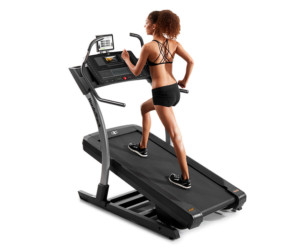
Treadmills that go up to 40 percent incline are getting more popular, but just how high must the incline be before you should hold on while walking?
The TV commercials for the 40 percent incline treadmills show the models walking without holding on, and also while holding on.
The manufacturer wants to appeal to the largest demographic possible.
To show only a hands-off walk would deter potential buyers – who are easily influenced by what they see in commercials — who think they’d fall off without holding on.
I know that sounds really silly, but manufacturers do not want to take a chance on deterring potential buyers, so they show both a hands-off and hands-on demonstration.
So never mind what the TV commercials show.
Let’s look at this from a fitness and mechanical perspective. First off, it’s logical to assume that anyone who’d want to purchase a treadmill for its 40 percent incline is not physically disabled.
That’s a very logical deduction. I can’t imagine a person with multiple sclerosis, cerebral palsy or Meniere’s disease wanting to use a 40 percent incline … though anything is possible, for sure!
It’s safe to assume that people who are eager to walk on a 40 percent grade are free of disease or injury that impairs their balance and steadiness.
Should You Hold On When Walking a 40 Percent Incline?
As a former personal trainer at a health club where I worked with many people on their treadmill use, I say NO.
From the standpoint of layperson’s common sense, I also say NO.
It’s quite simple, no PhD in exercise physiology required to understand:
What’s the point of walking on a 40 percent grade if you’re going to hold on, which nullifies the slope effect?
If you hold on, you’ll deprive yourself of the 40 percent incline benefits:
• Works the low back like mad – in a way that deadlifts and yoga do not, though keep doing THOSE too if you already are.
• Provides a way to fire up your heart rate without generating impact – appealing to those whose knees can’t tolerate the impact of jogging.
• Strengthens the ankles.
• Stretches the Achilles tendon and calves.
• Works the glutes more than do lower inclines (though it will NOT make your butt bigger).
• Concentrates more work in the quads than do lower inclines.
• Can prepare your body for steep outdoor hiking.
• Can really get your heart rate up at a slow speed.
• Will improve balance and proprioception.
These benefits will be cancelled out if you hold on. Does the image below make sense?
Holding on in front causes one’s body to angle back, cancelling out the net effect of the incline!
Perhaps you’re wondering if a LIGHT grip won’t make a difference, especially if it’s on the side rails and you’re making an effort to keep your body vertical.
Well, the problem with even a light hold is that it encourages the potential to tighten it – something you may not even be aware of as you get lost in the workout. It also subtracts workload, even if you try to keep vertical.
Why bother holding on at all?
What’s the purpose of a 40 percent grade if you’re going to hold on? This opposes its novelty in the first place.
The rails are there to grab onto in case you start feeling off-balance. Re-steady yourself and then let go.
Swing your arms (you need not exaggerate) as you would if you were climbing a steep hill outdoors.
Conducting 40 percent walking workouts without holding on will give you a true sense of accomplishment, especially if you’ve been leading a sedentary life.











